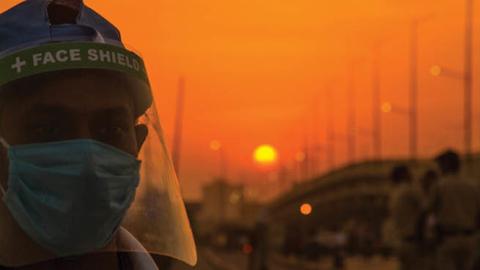View Full Report in PDF Format
For an update on the progression of the pandemic in South Asia, see Aparna Pande and Husain Haqqani’s memo, Nine Months of COVID-19: The Impact on South Asia
The world’s most populous region, South Asia, with almost 1.9 billion people living in eight countries, has so far had fewer reported infections and fatalities per capita from the novel coronavirus than projected in early models. However, the region is unlikely to escape the widespread disruption and damage felt across the globe, and its worst health-care crisis may be yet to come.
In South Asia, as in other regions, the COVID-19 pandemic is testing the capacities of states to provide security and effective healthcare and to maintain essential services. It is also having an impact on fragile democratic institutions and societal bonds, in addition to putting considerable strains on the economy.
It may be that India, Pakistan, and other countries in South Asia have a low number of confirmed cases because the region is behind on testing, tracing, and isolating. Although inadequate testing is a problem in other parts of the world, too, it serves as an excuse for South Asia’s governments to keep the publicly stated numbers in check.
Governments share figures only for those who have been tested or otherwise accounted for in woefully ill-equipped public-health systems. There may be other patients who are not being counted, inadvertently or in some cases, deliberately. Government-mandated lockdowns, first introduced in Bangladesh and India and subsequently adopted across South Asia, have been somewhat successful, but the extent of the region’s exposure to COVID-19 is still not fully known.
India and its neighbors have many people under the poverty line, insufficient investment in social capital, especially healthcare, and large migrant labor forces. Even if the numbers of fatalities and confirmed cases remains low, the International Monetary Fund (IMF) has predicted that the pandemic will have a devastating impact on South Asia’s economies.
The IMF projects that India’s economy, which until recently was expected to contribute to global growth, will experience further slowdown. According to the IMF, Nepal, one of the smaller South Asian economies, will become the fastest-growing economy in the region with 2.5 percent growth, followed by Bangladesh with 2 percent, then India with 1.9 percent.
Sri Lanka is expected to have negative growth, with its economy shrinking by half a percent. Pakistan is likely to be the worst hit, with negative economic growth of 1.5 percent.
India, the largest country in the region, would ideally be suited to playing a major role in rebuilding its neighborhood because of its central location and large economy. It would be in the U.S. interest to encourage this outcome. India, however, would simultaneously be dealing with a slowing economy, rising social tensions, divisive politics, and insufficient investment in healthcare.
There is a geopolitical reason, too, for the United States and other democracies to encourage Indian regional leadership in post-pandemic rehabilitation. China has been expanding its influence in South Asia and could step in more aggressively to assist weakened governments with a view to controlling them in the future. India could emerge ahead in the contest with China with the right mix of policies.
India has opted for a regional response to the COVID-19 crisis and offered technical assistance and medical equipment to its neighbors, some of whom remain wary of China. Beijing’s lack of transparency at the outset, when the coronavirus first appeared in Wuhan, is also unlikely to enhance confidence in Chinese leadership. China would still have the advantage of its larger foreign currency reserves and the ability to offer loans and investment. This can be mitigated through closer collaboration between India, the United States, and other democracies.
The country worst hit by COVID-19 in South Asia is China’s most dependable ally, Pakistan, the second-largest country in the region. A fragile state with a large military, a strong jihadi terrorist presence, and nuclear weapons capability, Pakistan’s many fault lines are likely to be exacerbated by the pandemic and the economic downturn in its aftermath. The slow and fumbling response of Pakistan’s civilian government has already positioned the military to step in and take charge once again, diminishing Pakistan’s civilian democratic facade. This will only strengthen China’s grip on Islamabad.
Pakistan’s response to the coronavirus resembles that of Sri Lanka, another country heavily indebted to China. Both Pakistan and Sri Lanka focused their early comments on praising Beijing. Pakistan even helped Chinese propaganda by spreading conspiracy theories claiming that the virus originated with British or US biological warfare preparations.
Although Pakistan’s precarious economic situation has led it to seek assistance from the IMF, it will likely not take long for it to turn to China for help, just as Sri Lanka has done. Western governments could continue to try to aid Pakistan, hoping to keep it out of China’s stranglehold, but that would be the pursuit of sunk cost. Pakistan’s embrace of China is already tight; its military leadership’s antipathy to India is unlikely to help reorient Islamabad towards the West any time soon. Indian and Pakistani troops have exchanged fire along the Line of Control (LOC) in Kashmir, following intelligence reports that Pakistan might be increasing terrorist infiltration into Indian-controlled territory.
That Pakistan might try to use the COVID-19 emergency to expand subconventional war against India, or that India believes it would, reflects the depth of mistrust between the two neighbors. Pakistan relies on its close ties to China to pursue what its generals see as permanent conflict with India. In the aftermath of the ravages of the coronavirus, China-Pakistan relations can be expected to remain close, setting the stage for a new round of competition between China and India for regional pre-eminence.
Following is a country-by-country report, with inputs from experts on the ground, on the coronavirus pandemic’s impact in South Asia and its human, economic, and political consequences.




















